#rose milkweed
Text
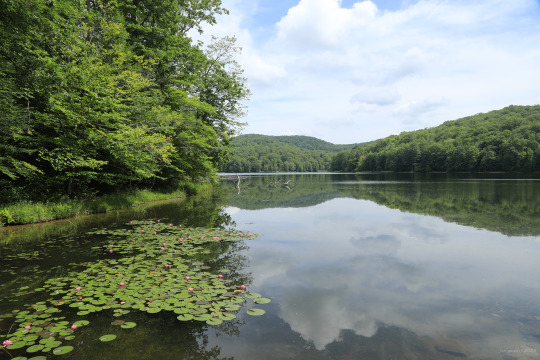

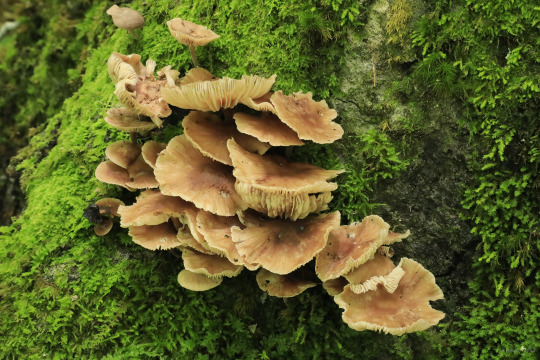

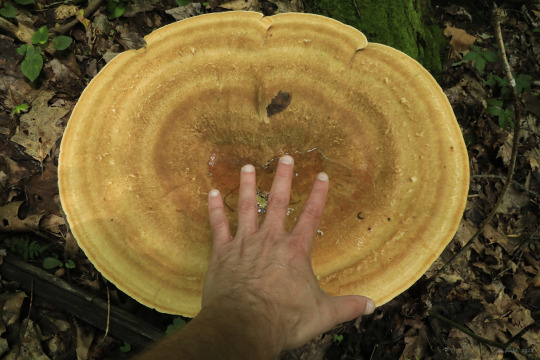
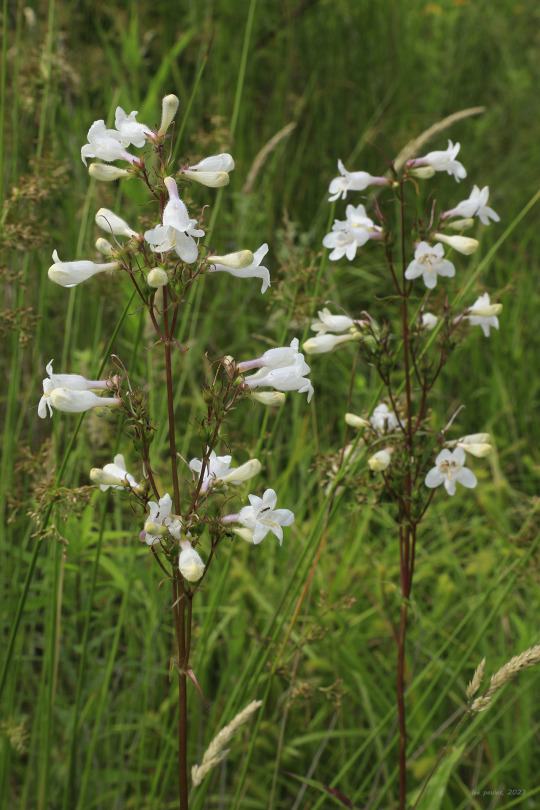
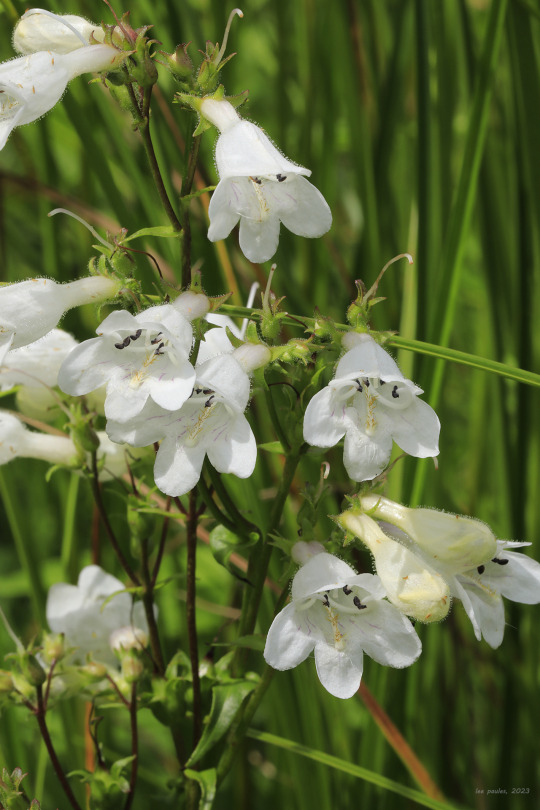

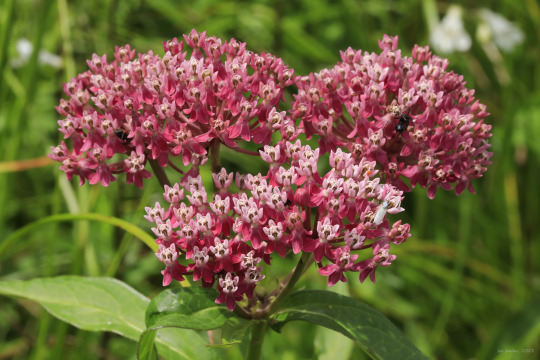
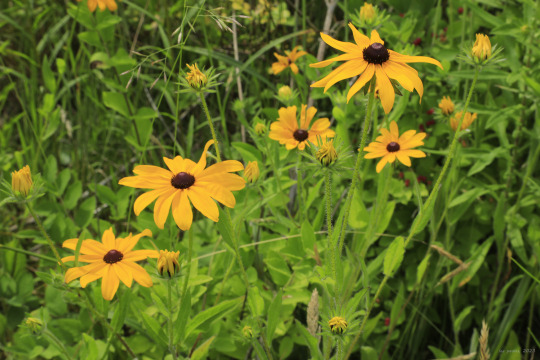

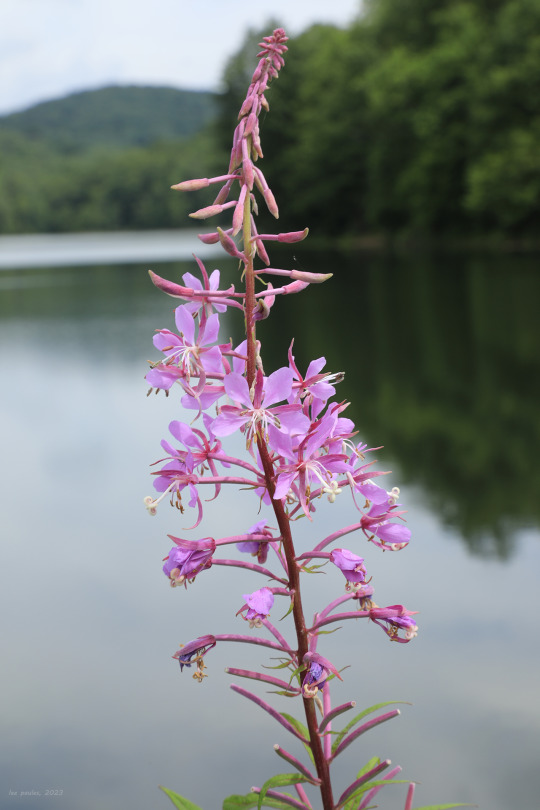

Early summer at Summit Lake, a quick detour off the Highland Scenic Highway in the Monongahela National Forest.
From top: an unidentified fungi growing in a mossy nook; an impressive young Berkeley's polypore (Bondarzewia berkeleyei), which is not a true polypore but a member of the Russulales order; another massive Berkeley's polypore with my hand for perspective - these beauties can grow up to three feet wide and produce additional shelf-like caps from a single stem, giving them a tiered appearance as they mature; the tall and stately foxglove beardtongue (Penstemon digitalis), whose profusion of tubular white flowers draws hordes of long-tongued bees and hummingbirds from late spring to early summer; common milkweed (Asclepias syriaca), whose large, dangling umbels of pink to purplish flowers are Mother Nature's ultimate pollinator buffets; swamp milkweed (Asclepias incarnata), also known as rose milkweed, a wetlands-loving beauty with narrow, lanceolate leaves; black-eyed Susan (Rudbeckia hirta), an irresistible summer aster with a prominent, dark brown button at the center of its flower head; and the sensual arc of a fireweed (Chamaenerion angustifolium), whose flowers have elongated, dangling stamens and a four-cleft, curling stamen.
#appalachia#vandalia#west virginia#wildflowers#flora#allegheny mountains#monongahela national forest#wv route 150#highland scenic highway#summit lake#early summer#fungi#berkeley's polypore#foxglove beardtongue#common milkweed#swamp milkweed#rose milkweed#black eyed susan#black-eyed susan#fireweed
136 notes
·
View notes
Text

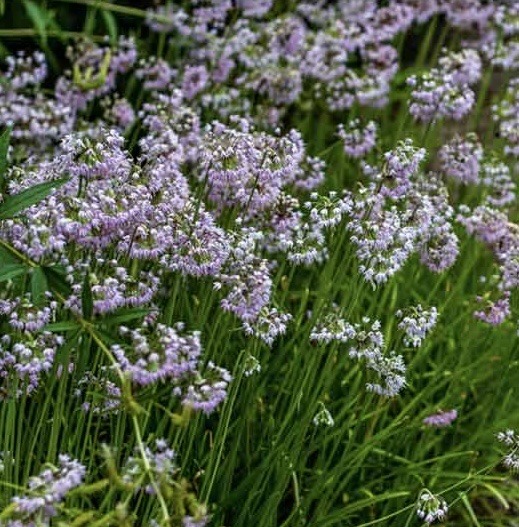
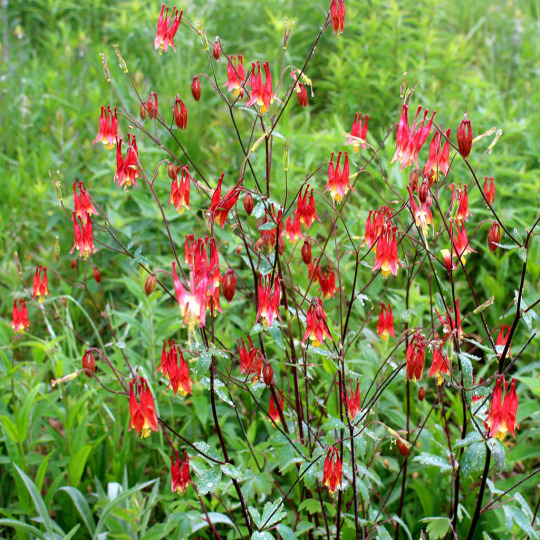

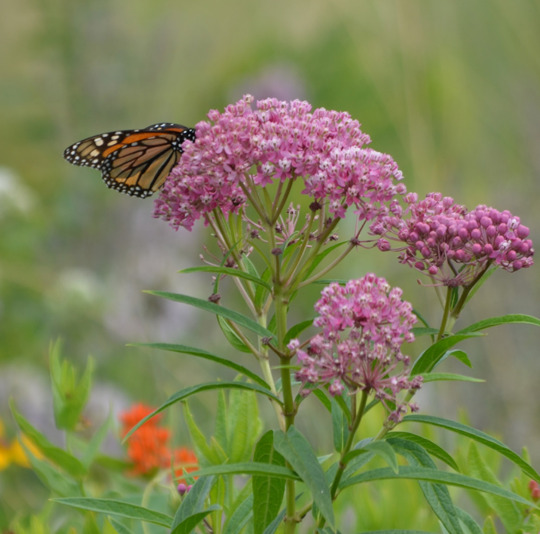


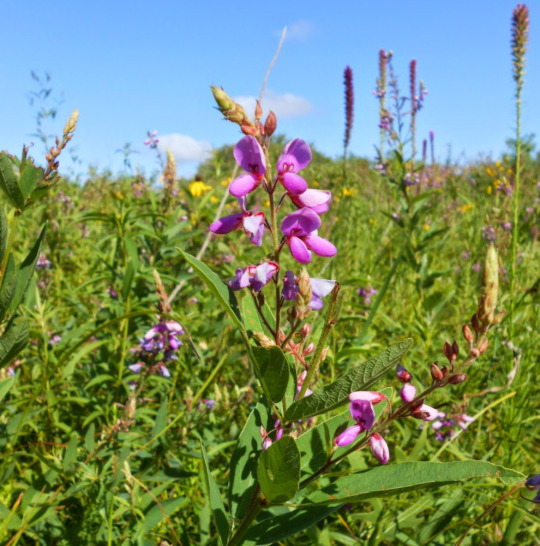
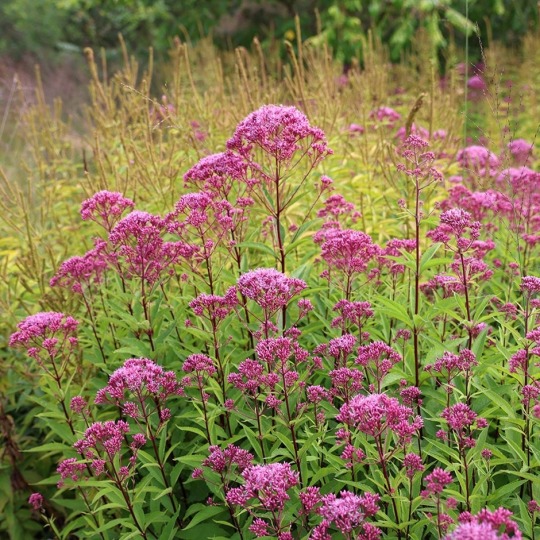
#milfoil#lady leek#granny’s bonnets#wild ginger#rose milkweed#butterfly milkweed#turtleheads#showy trefoils#spotted Joe-Pyes#boneset#wild strawberry#wild geraniums#rose mallow#button blazing star#marsh blazing star#native plants
30 notes
·
View notes
Text

milkweed and her million children and husbands that look suspiciously similar
#leaf#milkweed#splinter#shivering rose#morning fire#hazel burrow#patch pelt#beech tail#clover#bramble#thistle#warrior cats#wc#ray art
158 notes
·
View notes
Text
Round 4; A bouquet of rue, tansy, monkhood, milkweed and dame's rocket Vs A bouquet of dandelions, buttercups, roses, both black and yellow and sunflowers

First, let's talk about the bouquet of rue, tansy, monkhood, milkweed and dame's rocket
Meaning and why this flower was chosen:
Rue, which is used to symbolize regret partly because it’s in the name, represents this character, who bears deep regret for an incident more personally impactful than anything else could be; it wasn’t the character’s fault, but nonetheless it begs forgiveness, and in many ways it’s inseparable from the incident itself.
Tansy, which can mean a declaration of war, thus symbolizes this character who is defined by its existence in a context created by violence. It wouldn’t be who it is if not for (essentially) war being waged against it and its family. And after that (if you could even say there is an after for this character), it lives in wholehearted (and correct) conviction that it has a nemesis out there, a true and personal enemy, who will declare their ill intentions to it clearly and politely. So it would have been perfectly feasible and appropriate for its nemesis to literally send it a tansy bouquet.
Monkshood, which is a warning of nearby danger and thus represents this character’s knowing fear of its nemesis.
Milkweed, which symbolizes freedom and remembrance, fits here because this character kept running its whole life in order to get some semblance of freedom and safety for its family, and because remembrance is something built into the foundation of its story.
Dame’s rocket is representative of deceit, and this character is an unreliable narrator who bluntly claims the right to lie outright, as such rights must be exercised lest they wither.
Description:
This character is a sentient building who cannot substantially communicate except through the fourth wall. It is a traveler, an immigrant, an escape route, a victim, a trauma, a gasp of desperation, and an act of lines crossed. Many things have burned in its hearth fire. It has a nice rooftop garden. It created a multiple-choice backstory for itself—many lies, of course. It’s gone through some major renovations by its resident family. It’s got this pretty mural on its front door. It has given its audience (i.e. the real actual readers) a death threat.
Check its post here
Now let's talk about the bouquet of dandelions, buttercups, roses, both black and yellow and sunflowers
Meaning and why:
Yellow is the color often associated with friendship, and his whole thing is that he wants to make friends with everyone. Black flowers usually have slightly more negative meanings, which does fit with his often unsettling behaviors. So despite genuinely wanting to make friends, he has some off putting vibes about him that hold him back.
Description:
— a guy who only wants to make friends (and help save the world along the way) but is far better at making everyone around him extremely uncomfortable instead. it isn't on purpose, he's actually a real sweetheart, but he's very unfortunate in that he has a really creepy voice and a terrible habit of asking people to smell him. yikes
— While his specy is unknown, we do know for sure he has some kind of connection with nature (whether he's a plantfolk, a human who has nature powers, perhaps a mix of both). As mentioned previously, despite his often off putting actions and behaviors, he trully genuinely just wants to make friends with people, but oftens scares them off. By the end of his journey, however, he manages to make a few close friends! He's especially close to an arson loving hivemind, who he has an ambiguous relationship with (are they best friends? romantically involved? both are hinted at but never comfirmed)
Check his post here
#round 4#mysterious character: a bouquet of rue - tansy - monkhood - milkweed - dame's rocket#mysterious character: a bouquet of dandelions - buttercups - roses both black and yellow - sunflowers
20 notes
·
View notes
Text
Bzzz!
Just some bees in my garden and in the fields and on a neighbourhood walk. :)
Featured bees include bumblebees (native), green sweatbees (native), honeybees (invasive), carpenter bees (native), and some I'm not sure about.
Featured flower hosts include bull thistles (invasive weed), rose of sharon (invasive), New England aster (native), cup plant (native), starthistle (not native), Nuttall's sunflower (native), purple coneflower (native), anise hyssop (native), white wood aster (native), swamp milkweed (native), sow thistle (invasive weed), creeping charlie (invasive), creeping thistle (invasive weed), wild rose (native maybe), wild bergamot (native), bride's feathers (native), bigleaf lupin (native maybe or invasive), and upright prairie coneflower "Mexican hat" (native species, but a cultivar).
All my photos, unedited. Don't mind the weirdness of the third last photo. It's my phone's "portrait" which I found out belatedly can have, uh, interesting results.



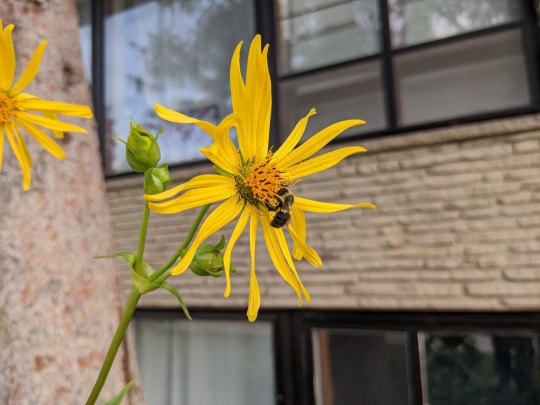



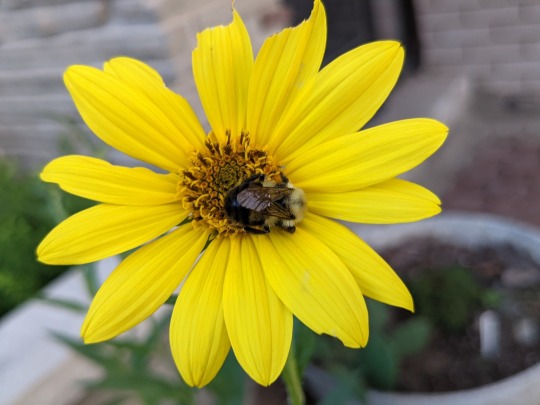




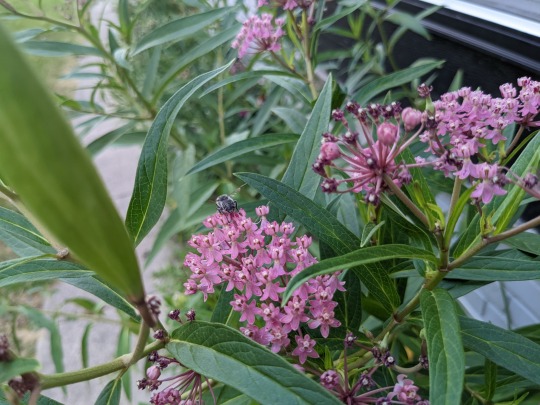

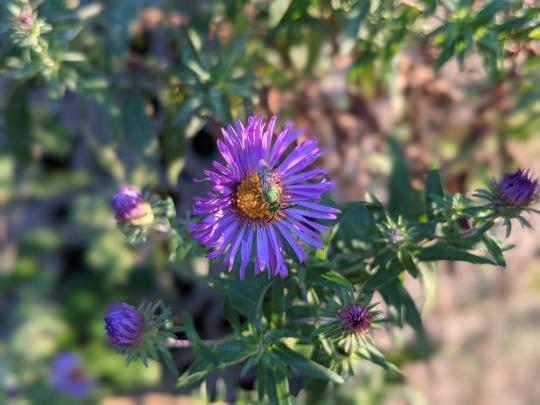

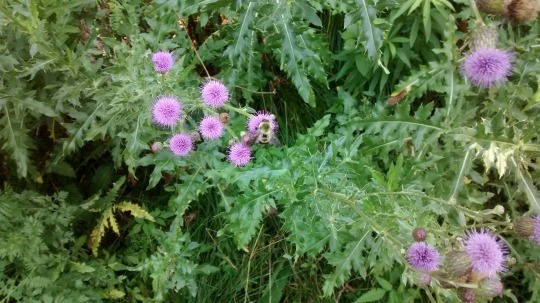
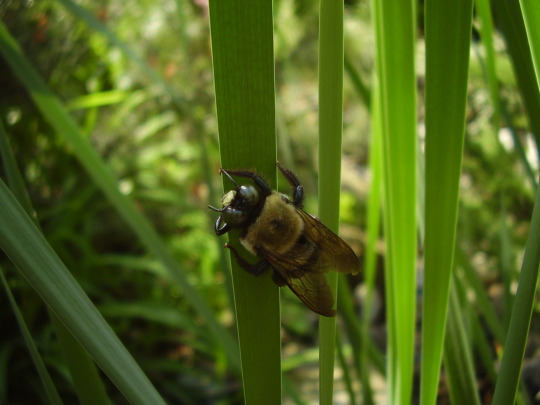

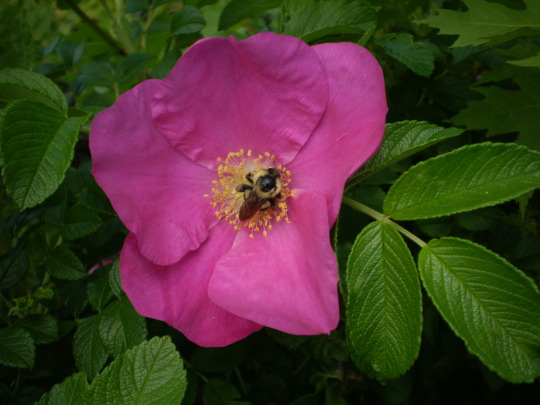

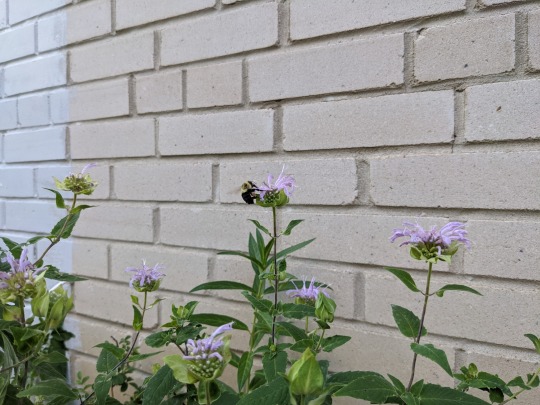


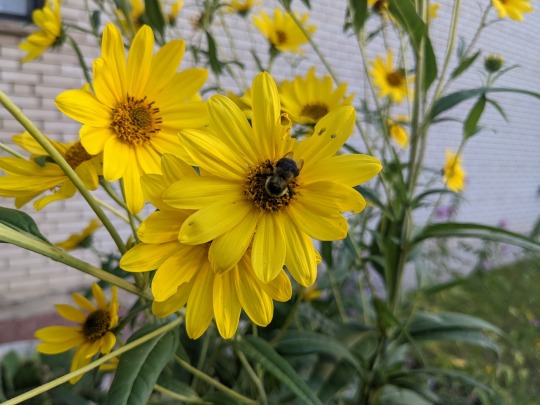
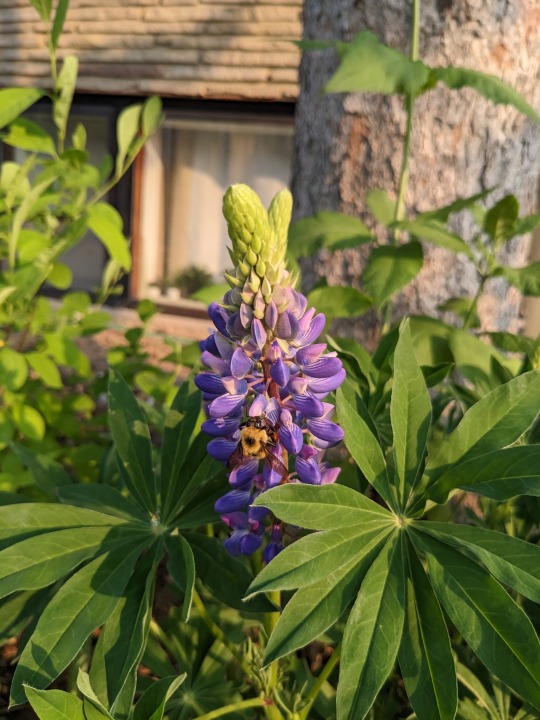

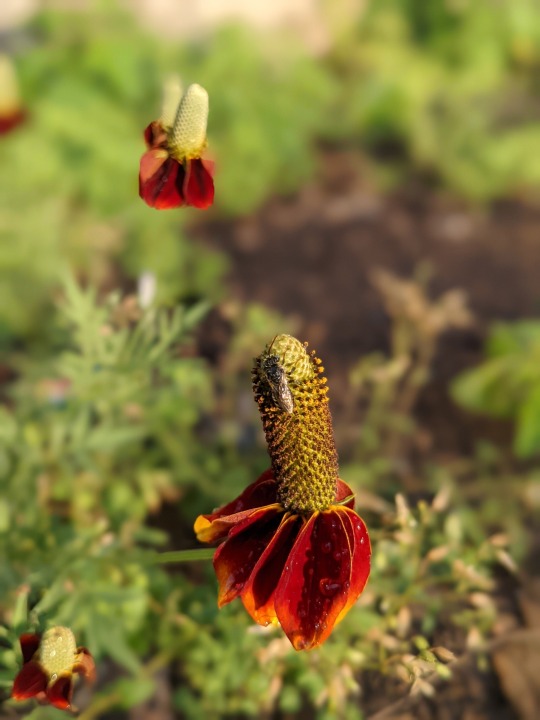
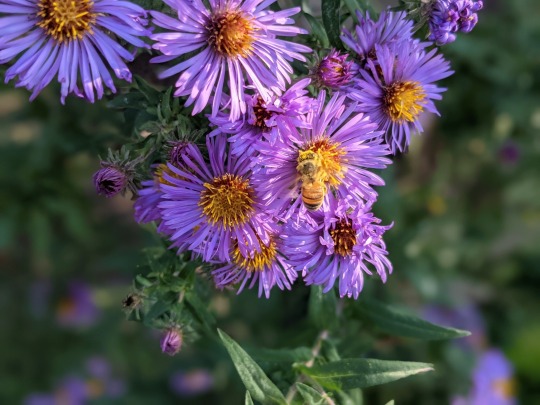

#bees#bumblebees#insects#hymenoptera#bees wasps and ants#honeybees#sweatbees#carpenter bees#my photos#photography#blackswallowtailbutterfly#bees on flowers#flowers#native North American plant species#native North American insect species#thistles#milkweed#sunflower#purple coneflower#upright prairie coneflower#swamp milkweed#lupin#bigleaf lupin#asters#New England aster#white wood aster#coneflowers#wild rose#starthistle#creeping charlie
7 notes
·
View notes
Text
I didnt feel like writing a card for my mom's bday so instead I decorated the box that the chocolates I always get her come in☺️☺️

also. I can name all of the flowers/plants on here.
milkweed
lavender
sword ferns
jasmine
goldenrod
sunflowers
some random mushrooms in a plantain plant (plantains are actually really cool weeds that might grow in your yard. you can use them to soothe bug bites!)
violets
snapdragons
bleeding hearts
aloe
clover(like the little flowers)
virginia bluebells
and honeysuckle!!
and then there's also little bumblebees that I drew to fill up the empty spaces
#plants#its my moms birthday today so this is her present#these are mostly native to our area#my moms really into gardening#and one year she spent several months learning about bees to prepare to get a bee hive#and then we found out that our borough didnt allow them😓#but now she loves bees a lot#and likes to plant plants that are really good for them and other pollinators#and we have like a yard with 2 different parts#so the part closest to the house is like a normal yard#and she has garden best there for vegetables n stuff#and then the back part has like a little stream by it#and she just lets all the plants grow#except for some paths and a space for our fireplace#but she did rip up some red vines with thorns on them#turns out they were and invasive type of rose#and then a bunch of milkweed grew there!!#which if you dont know is really good for butterflies!#but my mom is like a really amazing person#i love her so much and shes so cool#and shes also like really involved with our local politics#and one time she went to the school board to keep a book from being banned#but shes just like#the best mom i could ever ask for#my art#native plants
10 notes
·
View notes
Note
What side of the family does Milkweed get her autism from?
She gets it from Inky Rose! Her egg donor/biological mother. Inky seemed like the type who doesn’t express her emotions very much through tone or facial expressions like most neurotypical folks would. I know this was played up to showcase her immersion in the goth aesthetic, but for storytelling’s sake I feel like it could also be interpreted as an insight into the way her mind works. Milkweed, Moondancer, and Flash Magnus still have a relationship with Inky Rose so you’ll get to see them interact!
#AskKind#auraverse#milkweed#inky rose#autism#autistic oc#autistic representation#next generation#my little pony#mlp fim#mlp g4#asks open#send asks#send me asks#ask me stuff#ask me things#ask me anything
7 notes
·
View notes
Text
July 2022: Flowers & Sky

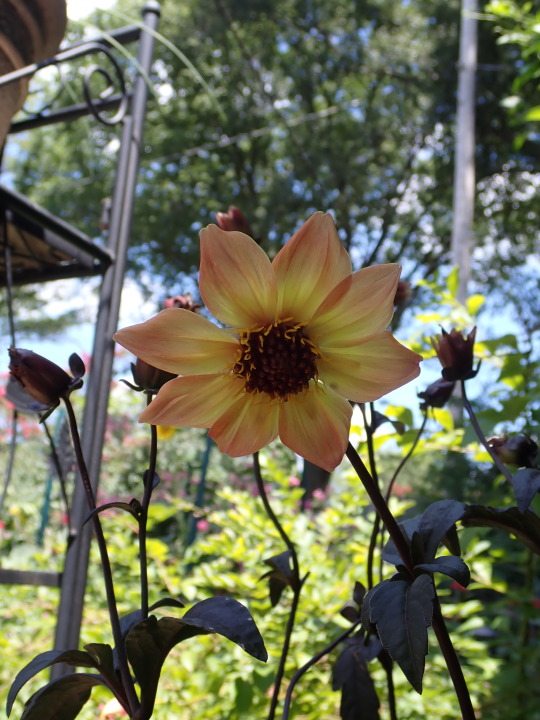


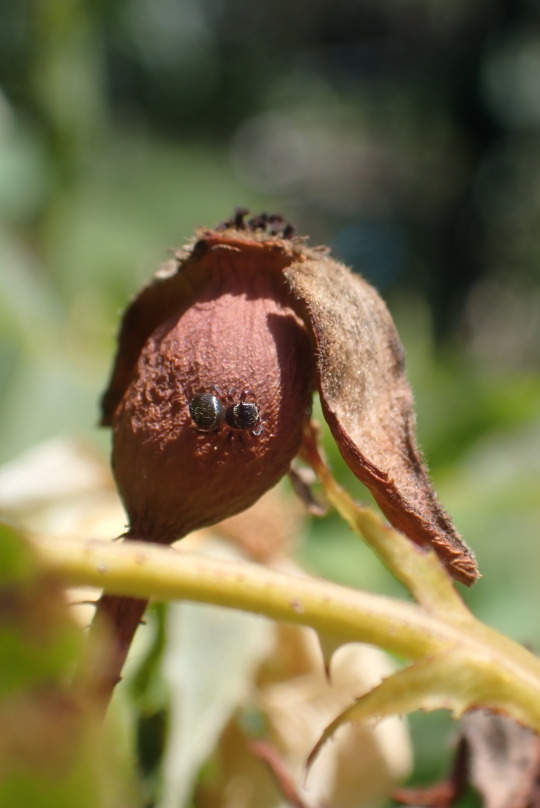

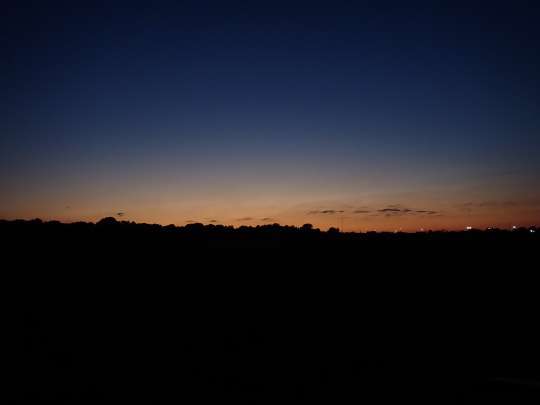
#garden#backyard garden#flowers#dahlia#rose#lady of shalott rose#swamp milkweed#jumping spiders#rosehip#community garden#shelby county community garden#plot 420#sunset#sky#twilight#dusk#life in memphis#crocosmia
3 notes
·
View notes
Text


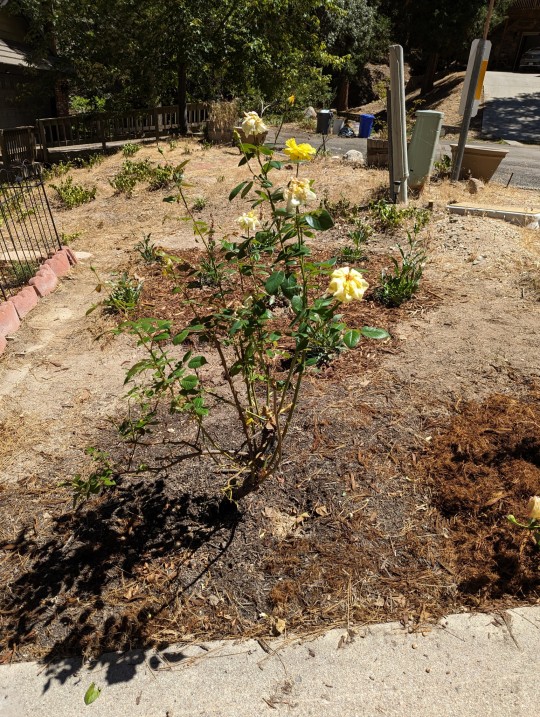

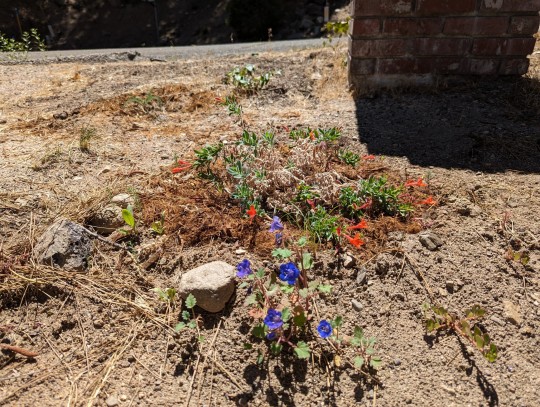

More before pics.
#milkweed#California Fuchsia#firecracker penstemon#non native roses#these poor roses are fucked if the wind gets strong#pointy little divas
0 notes
Text
I have an essay brewing in my head constantly about lawns. Which, well, unsurprising, since I post about how I hate lawns all the time, but I think the "lawn" and "landscaping" centered way of thinking about Places Outside is a Bigger Thing that Connects to Other Things
(What isn't? Having ideas about concepts is always like this.)
I will introduce my ideas by a situation where they apply: Sometimes life-forms mimic other life forms. One form of mimicry is called Vavilovian mimicry, where weed species in crops grown by humans evolve over time to be more similar to the crops.
Vavilovian mimicry basically helps weeds survive because the weeds are adapted to the care-taking regimen of the crops, and because the human caretakers of the crop can have a hard time telling them apart, which means they might say "Ehh...I'll wait until it grows up so I can be sure I'm not pulling up my crop."
I think there's something similar at work among flower gardens and landscaping...but it's different.
Regular people don't know the name of every plant that might possibly grow in their flower beds, and they often pull up plants they don't know just because they don't know them. They sometimes say they pull up a plant that "looks weedy" or "looks like a weed."
I think to myself...what does "weedy" look like?
This question collided unexpectedly in my brain with an insight I had about invasive species that I could not explain.
I have to get rid of a lot of Callery pear, wintercreeper, honeysuckle, burningbush, privet, English ivy, and other plants that are invasive where I live. And strangely- many invasive plants look similar in ways they don't share with very many native species. They tend to have small, round or squat, glossy leaves, and they tend to have a very dense growth habit.
I can think of several possible explanations: Maybe these species thrive in North America today because of the loss of controlled burning, but their characteristics look so distinct next to native species because they relate to things that would make a species fire-intolerant? This doesn't seem quite right, since it doesn't predict level of fire-adaptedness in native species.
Another explanation is better: they were selected for these traits by humans for their usefulness in landscaping. Dense growth habit would be useful for creating hedges or ground covers. This is why many invasives were originally planted, right? And small leaves might feel or be perceived as less "messy" when they fall.
But I think this is a clue to something else going on. What does "weedy" look like?
Some plants go on one side of "weeds vs. flowers" and some on the other, and it's almost totally arbitrary...so how do gardeners make the call so decisively?
I think about the commonest "landscaping" plants- Knock Out roses, hostas, petunias, begonias, boxwoods and so on- they share a lot of the characteristics mentioned above. Shiny or at least smooth, typically small and squat leaves, dense and compact growth habit.
Then I think about some of the commonest and most important "weedy" native wildflowers, such as goldenrods, asters, milkweeds, Joe-Pye weed, ironweed, sunflower. They all differ from the above in at least one striking way. Mostly, they have hairy leaves and stems, long and thin leaves, and a tendency to grow up tall before blooming. Milkweed has smooth leaves, but its leaves are long and very big. Hmm...
And I think I can guess where this is coming from.
Landscaping and garden designs often look like this


See how the plants are drawn and arranged to cover a space in two dimensions, mostly not overlapping with each other? This is very easy to plan and design. And those common landscaping plants I mentioned—hostas, Knock Out roses, boxwoods, and so on—are very good at acting just like a two-dimensional representation of them does. Just look, you can see them:
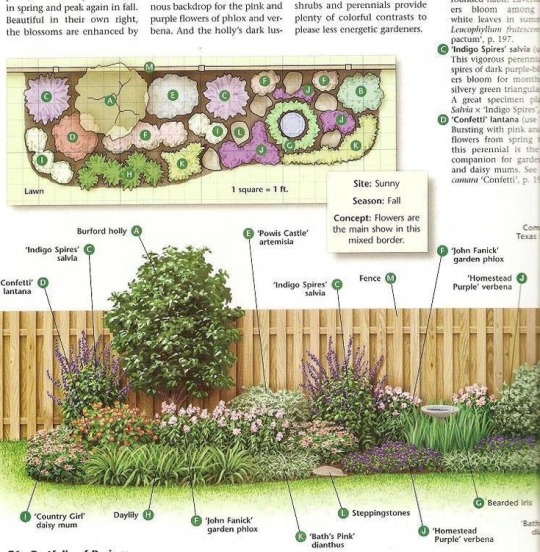
Now look at those important native wildflowers I mentioned:
Goldenrod

Ironweed
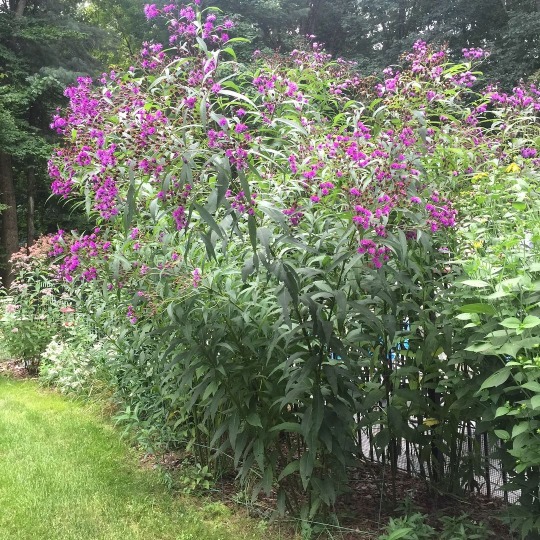
Milkweed

These guys don't fill much space in a horizontal plane, they go straight up. They don't exclude other plants from very much space either. Plants could grow under them and among them. So they're not very good for "filling up" space, and their opener, lankier, less dense shape doesn't do a good job at blocking other plants from growing.
In a garden of North American prairie- or meadow-adapted plants, the plants wouldn't exclude each other and stay within their designated spots because they're evolved to intermix with a great variety of plants.

"Separateness" is a big part of the typical "landscape" aesthetic. These plants are very neatly separate from each other. This is what looks "neat" and well-kept to us...the opposite of "weedy."
This could mean our garden and flower beds are affected by a selective pressure a lot like the Vavilovian mimicry situation. But instead of weeds being selected to look like intentionally grown plants, the intentionally grown plants are being selected to look different from weeds.
The subtle difference makes perfect sense. In a field, the rule is "leave the plant there if you're unsure" because that's your food. In a flower bed, the rule is "get rid of the plant if you're unsure" because having weeds is more aesthetically unacceptable than having blank space.
The point is: Ecology needs to be a big part of gardening and landscaping, because you are DOING ecology. Even if you don't know the evolutionary principles, you're acting them out.
Just like the ineffable preferences of female birds give the males weird elaborate display structures, ineffable aesthetic "senses" that govern our "built" world slowly turn it into something weird.
2K notes
·
View notes
Text

Headline by: Ryan Burns. “Ground Has Been Broken on Klamath River Restoration, the World’s Largest-Ever Dam-Removal Project.” Lost Coast Outpost. 23 March 2023.
---

The world’s largest dam removal in history is slated for 2023. Led by Indigenous tribes in partnership with organizations, lawyers, scientists and activists, the project will remove four dams, clearing the way for the lower Klamath River to flow freely for the first time in more than a century.
Headline and italicized text excerpt by: Malia Russ. “The Science of Saving Salmon as Klamath Dams Come Down.” UC Davis - Blogs - Climate. 24 February 2023.
---

Headline by: Jackson Guilfoil. “Klamath dam removals, habitat restoration, begins.” The Mercury News. 25 March 2023.
---

Headline by: Kale Williams. “‘The salmon are coming home’: Work begins on Klamath River dam removal.” KGW8. 27 March 2023.
---



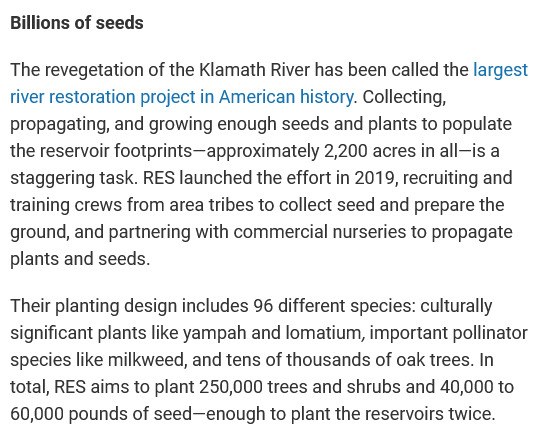
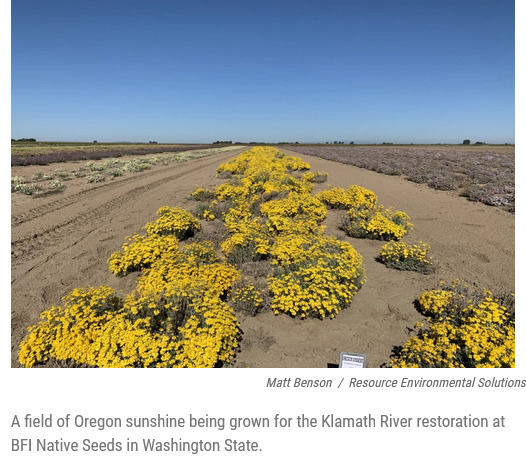
Iron Gate is a sinuous, skinny reservoir tucked into the folds of the Siskiyou Mountains. Draining it will expose about 900 acres of wet mud. “It’s our job to make sure it’s revegetated. We want that to be revegetated with a healthy native plant ecosystem,” says Joshua Chenoweth, Senior Riparian Ecologist for the Yurok Tribe who is leading the replanting effort. [...] Last fall, they seeded the strip with a mix of native grasses and flowering plants; now, they’re installing young shrubs and trees: buckbrush, serviceberry, and Oregon ash, along with the Klamath plum. Collectively, these plants will create a “wall of green,” taking up space that would have otherwise been overrun by non-native plants [...]. The revegetation of the Klamath River has been called the largest river restoration project in American history. Collecting, propagating, and growing enough seeds and plants to populate the reservoir footprints -- approximately 2,200 acres in all -- is a staggering task. [...] Their planting design includes 96 different species: culturally significant plants like yampah and lomatium, important pollinator species like milkweed, and tens of thousands of oak trees. [...] What will a restored, wild Klamath River look like? Imagine it. Stand at the Wanaka Springs boat launch and picture Iron Gate reservoir drained. The river has found its channel at the base of its original canyon. Willows flank the banks. Much of the reservoir footprint is flush with upland vegetation -- oak copses; thickets of buckbrush and Klamath plum; blooming rose and lupine.
---
Headline, images, captions, screenshot, and italicized text excerpt from: Juliet Grable. “After the dams: Restoring the Klamath River will take billions of native seeds.” Jefferson Public Radio. 13 March 2023.
2K notes
·
View notes
Photo
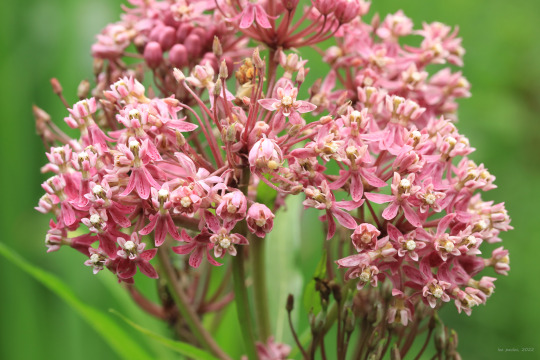
Rose milkweed (Asclepias incarnata), also known as swamp milkweed, the last of the milkweeds to bloom in this area.
#appalachia#vandalia#west virginia#summer#wildflowers#flora#asclepias incarnata#rose milkweed#swamp milkweed#west virginia botanic garden#tibbs run preserve
64 notes
·
View notes
Text
Sowing - Part 2
#native plants#seeds#milfoils#showy treefoils#rose milkweed#butterfly milkweed#gardenblr#tiktok#me#my face
5 notes
·
View notes
Text
Round 1; A bouquet of orange lilies, yellow roses, buttercups, aconite, sunflower, hollyhock and lotus Vs bouquet of jasmine, milkweed, dandelion, poppy and oenothera
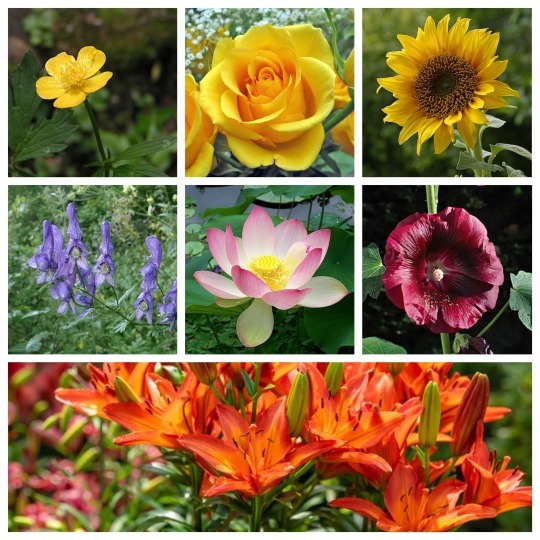
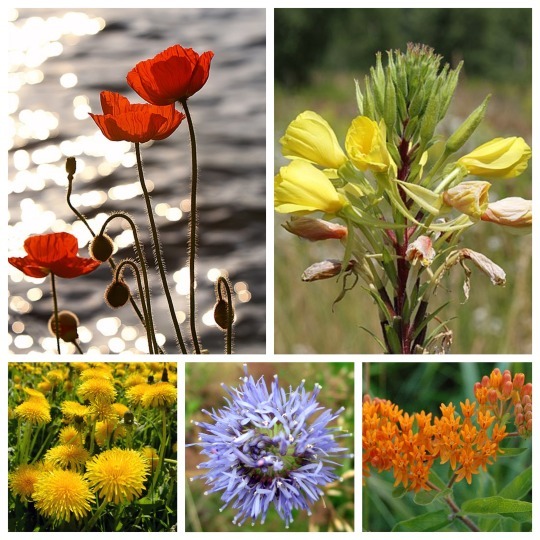
If you know who they are, or are pretty sure of it, please don't tell until this poll has ended!
First, let's talk about the bouquet of orange lilies, yellow roses, buttercups, aconite, sunflower, hollyhock and lotus
Meaning and why these flowers were chosen:
Orange Lilies (Pride and Humiliation; he is one of the most prideful men imaginable, and every outcome ends in his humiliation)
Yellow Roses (Greed and Cowardice; he has a desire for everything he believes he's inherently owed, but he's too cowardly to act directly on his own without some sort of scheme)
Buttercups (Childishness)
Aconite (Decadence, Conceit, and Pomposity)
Sunflower (Freedom and Liberation; his greatest desires during the time he is known)
Hollyhock (Ambition; he wants to gain a place of incredibly high standing once he's free)
Lotus (Chastity; while the word is linked to him, it is in the sense of morality and virtue as concepts - and by extension, his shirking of such things for his own ends)
Meaning:
A man of former high station earned through nepotism who has found himself down on his luck, in a situation entirely of his own making; choosing to bribe the wrong people leads to such things. He hopes to find his way back to his 'proper' place someday, and he's not above employing the most underhanded means he can think of to do it.
No matter what path he takes, however, he ultimately ends up laughed at and in an arguably worse situation than he started. If you like men who are pompous and think/speak highly of themselves, but are actually very pathetic like a sad wet cat in a cardboard box, this is a man for you. He literally pouts and throws a tantrum when he's ignored, he's everything, he's the moment.
Check their post here
Now, let's talk about the bouquet of jasmine, milkweed, dandelion, poppy and oenothera
Meaning:
jasione (justice), milkweed (remembrance, dignity, freedom), dandelion (endurance, determination), poppy (peace, hope, resilience), oenothera (youth)
Description:
oh boy. his life has been in constant danger since age ten. he becomes King at the age of fourteen after causing a war by being naively kind. he wasn't supposed to exist, and consistently defies Fate in both a narrative and literal sense. he just wanted a calm life. he spent his childhood fighting tooth and nail for justice and kindness. the world needed a hero, and it might as well have been him.
Check their post here
#round 1#mysterious character 2: bouquet of orange lilies - yellow roses - buttercups - aconite - sunflower - hollyhock - lotus#mysterious character 2: bouquet of jasmine - milkweed - dandelion - poppy - oenothera
4 notes
·
View notes
Text
September 2023 witch guide
September 2023 witch guide
Full moon: September 29th
New moon: September 14th
Sabbats: Mabon September 23rd
September Harvest Moon
Also known as: Autumn moon, falling leaves moon, song moon, leaves turning moon, moon of brown leaves, yellow leaf moon, wine moon & Full corn moon
Element: Earth
Zodiac: Virgon& Libra
Animal spirits: Trooping Faeries
Deities: Brigid, Ceres, Ch'ang-o, Demeter, Freya, Isis & Vesta
Animals: Jackal & snake
Birds: Ibis & sparrow
Trees: Bay, hawthorn, hazel & larch
Herbs/plants: Copal, fennel, rye, skullcap, valerian, wheat & witch hazel
Flowers: Lily & Narcissus
Scents: Bergamot, gardenia, mastic & storax
Stones: Bloodstone, chrysolite, citrine, olivine, peridot & sapphire
Colors: Browns, dark blue, greens & yellows ( Earth tones)
Energy: Balance of light & dark, dietary matters, employment, health, intellectual pursuits, prosperity, psychism, rest, spirituality, success & work environments. Also cleaning & straightening mentally, physically & spiritually.
Technically, the Harvest Moon is the Full Moon closest to the September equinox around September 21st. The Harvest Moon is the only Full Moon name determined by the equinox rather than a month. Most years, it’s in September, but around every three years, it falls in October.
In September, the Full Moon is the Corn Moon from the Native American tribes harvesting their corn. It can also be the Harvest Moon, which corresponds with the Anglo-Saxon name, while Celtic and Old English names are Wine Moon, Song Moon, and Barley Moon.
Mabon
Also known as: Autumn Equinox, Cornucopia, Witch's Thanksgiving & Alban Elved
Season: Fall
Symbols: Acorns, apples, autumn leaves, berries, corn, cornucopia (horn of plenty), dried seeds, gourds, grains, grapes, ivy, pine cones, pomegranates, vines, wheat, white roses & wine
Colors: Blue brown, drk red, deep gold, gold, indigo, lead green, maroon, orange, red, russet, violet & yellow
Oils/incense: Apple, apple blossom, benzoin, black pepper, hay/straw, myrrh, passion flower, patchouli, pine, red poppy & sage
Animals: Dog, goose, hawk, swan, swallow & wolf
Stones: Agate, amethyst, carnelian, lapis lazuli, sapphire, yellow Agate & yellow topaz
Foods: Apples, blackberries, blackberry wine, bread, carrots, cider, corn, cornbread, grapes, heather wine, nuts, onions, pomegranates, potatoes, squash, vegetables, wheat & winw
Herbs/plants: Acorn, benzoin, cedar, corn, cypress, ferns, grains, hazel, hops, ivy, myrrh, oak, pine, sage, sassafras, Salomon's seal, thistle, tobacco & wheat
Flowers: Aster, heather, honeysuckle, marigold, milkweed, mum,passion flower& rose
Goddesses: Danu, Epona, Modron, Morrigan, Muses, Pomona, Persephone, Sophia & Sura
Gods: Esus, Green Man, Hermes, Mabon, Mannanan, Toth & Thor
Issues, Intentions & Powers: Accomplishment, agriculture, balance, goals, gratitude & grounding
Spellworks: Balance, harmony, protection, prosperity, security & self confidence
Related festivals:
• Sukkot- is a Torah-commanded holiday celebrated for seven days, beginning on the 15th day of the month of Tishrei. It is one of the Three Pilgrimage Festivals (Hebrew: שלוש רגלים, shalosh regalim) on which those Israelites who could were commanded to make a pilgrimage to the Temple in Jerusalem. In addition to its harvest roots, the holiday also holds spiritual importance with regard to its abandonment of materialism to focus on nationhood, spirituality, and hospitality, this principle underlying the construction of a temporary, almost nomadic, structure of a sukkah.
• Mid-Autumn festival- also known as the Moon Festival or Mooncake Festival, is a traditional festival celebrated in Chinese culture. Similar holidays are celebrated by other cultures in East & Southeast Asia. It is one of the most important holidays in Chinese culture; its popularity is on par with that of Chinese New Year. The history of the Mid-Autumn Festival dates back over 3,000 years. The festival is held on the 15th day of the 8th month of the Chinese lunisolar lunisolar calendar with a full moon at night, corresponding to mid-September to early October of the Gregorian calendar. On this day, the Chinese believe that the Moon is at its brightest and fullest size, coinciding with harvest time in the middle of Autumn.
• Thanksgiving- This is a secular holiday which is similar to the cell of Mabon; A day to give thanks for the food & blessings of the previous year. The American Thanksgiving is the last Thursday of November while the Canadian Thanksgiving is celebrated in October
• Festival of Dionysus- There were several festivals that honored Dionysus, the God of wine. It was a time of fun, games, feasting & drinking wine.
Activities:
•Scatter offerings in a harvested fields, Offer libations to trees
• Decorate your home and/or altar space for fall
• Bake bread
• Perform a ritual to restore balance and harmony to your life
• Cleanse your home of negative energies
• Pick apples
• Have a dinner or feast with your family and/or friends
• Set intentions for the upcoming year
• Purge what is no longer serving you
•Take a walk in the woods
• Enjoy a pumpkin spice latte
• Donate to your local food bank
• Gather dried herbs, plants, seeds & pods
• Learn something new
• Make wine
• Brew an apple cinnamon simmer pot
• Create an outdoor Mabon altar
•Adorn burial sites with leaves, acorns, & pinecones to honor those who have passed over & visit their graves
Many cultures see the second harvest (after the first harvest Lammas) and equinox as a time for giving thanks. This time of year is when farmers know how well their summer crops did, and how well fed their animals have become. This determines whether you and your family would have enough food for the winter. That is why people used to give thanks around this time, thanks for their crops, and animals, and food.
The name Mabon comes from the Welsh God, who was the son of the Earth Mother Goddess. However, there is evidence that the name was adopted in the 1970s, and the holiday was not originally a Celtic celebration.
Some believe Night and day are of equal legth and the God's energy & strength are nearly gone . The Goddess begins to mourn the loss she knows is coming, but knows he will return when he reborn at Yule.
Sources:
Farmersalmanac .com
Wikipedia
Llewellyn's Complete Book of Correspondences by Sandra Kines
A Witch's Book of Correspondences by Viktorija Briggs
Mabon: Rituals, Recipes & Lore for the Autumn Equinox Llewellyn's Sabbat Essentials
#witchcraft#wheel of the year#sabbat#mabon#Corn moon#Harvest moon#witchblr#wiccablr#paganblr#pagan#Wicca#grimoire#spellbook#book of shadows#witches of tumblr#tumblr witch#moon magic#witch tips#witch guide#traditional witchcraft#witch community#witch society#witchy things#witches#witch friends#greenwitchcrafts#All witches#correspondence#witchyvibes#witchcore
706 notes
·
View notes
Text
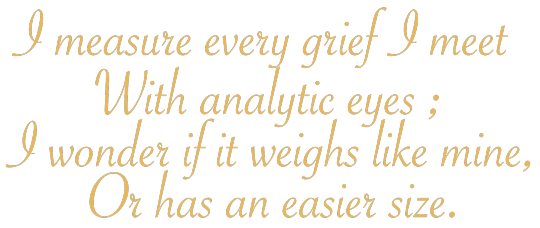


✯¸.•´¨*•✿ ✿•*¨`•.¸✯
finally got my new tablet!! who better to test it out with than @barrenclan’s cormorantpaw? i sprinkled some ✨symbolism ✨ in with the milkweed (remembrance, dignity, & freedom) and red roses (passionate & romantic love). plus a segment from emily dickinson’s griefs because I thought it fit him <33
229 notes
·
View notes